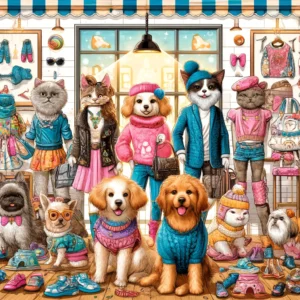Traveling with Your Dog: Tips for Safe and Enjoyable Adventures
Choosing the Right Mode of Transportation
When it comes to traveling with your dog, one of the first things you need to consider is the mode of transportation. Depending on the distance and destination, you have several options to choose from. If you’re planning a road trip, make sure your car is dog-friendly by installing a pet barrier or using a crate to keep your dog secure. It’s also a good idea to take your dog on short car rides before the trip to get them accustomed to the motion and to prevent car sickness.
If you’re traveling by air, it’s essential to check the airline’s pet policy and make the necessary arrangements. Some airlines allow small dogs to travel in the cabin with you, while others require them to be transported in the cargo hold. If your dog is too large to travel in the cabin, make sure to choose a pet-friendly airline that has a good track record of safely transporting animals. It’s also important to ensure that your dog’s crate meets the airline’s requirements for size and ventilation.
For those planning a vacation abroad, it’s crucial to research the entry requirements and quarantine regulations of your destination country. Some countries have strict rules regarding the importation of pets, including mandatory vaccinations and quarantine periods. It’s best to consult with a veterinarian or a pet travel specialist to ensure that you have all the necessary paperwork and vaccinations in order.
Regardless of the mode of transportation you choose, it’s important to pack essential items for your dog’s comfort and well-being. These may include food and water bowls, a leash and collar, a comfortable bed or blanket, toys, and any necessary medications. It’s also a good idea to bring along your dog’s medical records and a recent photograph, just in case they get lost during the trip.
1. Plan Ahead
Before embarking on any trip with your dog, it’s essential to plan ahead and make the necessary preparations. Here are a few things to consider:
- Health check: Visit your veterinarian to ensure that your dog is healthy and up-to-date on vaccinations. It’s also a good idea to ask for a copy of your dog’s medical records, just in case. Your veterinarian can also provide you with any necessary preventive medications, such as flea and tick prevention, to keep your dog protected during your trip.
- Identification: Make sure your dog has proper identification, including a collar with a tag that includes your contact information. You may also want to consider getting your dog microchipped. A microchip is a small device that is implanted under your dog’s skin and contains a unique identification number. If your dog gets lost during your trip, a microchip can greatly increase the chances of being reunited with your furry friend.
- Travel documentation: If you’re traveling internationally, research the entry requirements for your destination country and make sure to have all the necessary paperwork, such as health certificates and quarantine documents. It’s important to start this process well in advance, as some countries may have specific requirements that could take time to fulfill. Additionally, if you’re traveling within your own country, it’s a good idea to have a copy of your dog’s vaccination records with you, as some accommodations or attractions may require proof of up-to-date vaccinations.
- Packing essentials: Pack a travel bag for your dog with essentials such as food, water, bowls, medications, leash, poop bags, and a comfortable bed or blanket. It’s important to pack enough food for the duration of your trip, as it may not always be easy to find your dog’s preferred brand or type of food while on the road. Additionally, don’t forget to pack any medications your dog may need, along with a first aid kit specifically tailored for dogs. If your dog has any specific dietary restrictions or allergies, make sure to pack any necessary supplements or medications to accommodate their needs.
Planning ahead and making the necessary preparations will ensure that your trip with your dog goes smoothly and that your furry friend stays happy and healthy throughout the journey. By taking care of your dog’s health, identification, travel documentation, and packing essentials, you can focus on enjoying your trip and creating lasting memories with your beloved canine companion.
2. Choose Dog-Friendly Accommodations
When planning your trip, make sure to choose accommodations that are dog-friendly. This could include pet-friendly hotels, vacation rentals, or campgrounds. Here are a few things to consider when selecting accommodations:
- Research: Look for accommodations that specifically welcome dogs and offer pet-friendly amenities, such as designated walking areas or pet-friendly rooms.
- Reviews: Read reviews from other dog owners to get an idea of the experiences they had with their pets at different accommodations.
- Additional fees: Be aware that some accommodations may charge additional fees for pets, so make sure to factor this into your budget.
- Rules and regulations: Familiarize yourself with any rules or restrictions that the accommodation may have regarding pets.
Once you have narrowed down your options, it’s a good idea to contact the accommodations directly to confirm their pet policies and any specific requirements they may have. Some accommodations may have weight or breed restrictions, while others may require proof of vaccinations or a pet deposit. By doing your research and understanding the rules and regulations in advance, you can ensure a smooth and enjoyable stay for both you and your furry friend.
In addition to finding dog-friendly accommodations, it’s also important to consider the location and surroundings. Look for accommodations that are situated in areas with plenty of outdoor activities and attractions for dogs. This could include nearby parks, hiking trails, or dog-friendly beaches. Having access to these amenities will provide opportunities for exercise and enrichment for your dog during your trip.
When booking your accommodations, it’s a good idea to inform the staff that you will be traveling with a dog. This way, they can make any necessary arrangements and provide you with any additional information or resources that may be helpful during your stay. Some accommodations may even offer special services or amenities for dogs, such as dog-walking or pet-sitting services.
Remember, choosing dog-friendly accommodations is an important aspect of planning a trip with your furry friend. By taking the time to research and consider your options, you can ensure a comfortable and enjoyable experience for both you and your dog.
3. Prepare for Safe and Comfortable Travel
Ensuring the safety and comfort of your dog during travel is crucial. Here are some tips to help you prepare:
- Secure your dog: Whether you’re traveling by car, plane, or other means, make sure your dog is properly secured. Use a crate, carrier, or harness to keep your dog safe and prevent them from roaming around.
- Car travel: If you’re traveling by car, use a dog seat belt or a car crate to secure your dog. Avoid letting your dog stick their head out of the window, as this can be dangerous.
- Air travel: If you’re flying with your dog, check the airline’s pet policy and make sure to follow their guidelines. It’s also a good idea to book a direct flight whenever possible to minimize stress and travel time for your dog.
- Comfort: Make sure your dog is comfortable during travel by providing them with a cozy bed or blanket, their favorite toys, and familiar items that smell like home.
- Frequent breaks: If you’re on a long road trip, make sure to take frequent breaks to allow your dog to stretch their legs, go to the bathroom, and have some water.
Additionally, it’s important to consider the weather conditions and temperature during your travel. If you’re traveling during hot weather, make sure to keep your dog cool by providing plenty of water and avoiding leaving them in a parked car. On the other hand, if you’re traveling during cold weather, ensure your dog is warm by providing them with a cozy sweater or jacket and avoiding prolonged exposure to low temperatures.
Furthermore, it’s a good idea to familiarize yourself with the pet-friendly accommodations and facilities available at your destination. Research hotels, parks, and restaurants that welcome dogs, and make reservations in advance if necessary. This will ensure that your dog feels welcome and comfortable throughout your trip.
Lastly, don’t forget to pack all the necessary supplies for your dog’s travel. This includes their food, water, medications, and any other essentials they may need. It’s always better to be over-prepared than under-prepared when it comes to your dog’s well-being.
4. Research Dog-Friendly Activities and Destinations
When planning your itinerary, it is essential to research dog-friendly activities and destinations that you can enjoy with your furry companion. This will ensure that your trip is not only enjoyable for you but also for your beloved pet. Here are a few ideas to get you started:
- Outdoor adventures: Look for hiking trails, beaches, or parks that allow dogs. Taking your dog for a scenic hike can be a wonderful way to bond with nature and get some exercise together. If your dog loves the water, consider finding a dog-friendly beach where they can splash around and have some fun. Alternatively, you can pack a picnic and head to a dog-friendly park where you can relax and enjoy the beautiful surroundings.
- Dog-friendly attractions: Some tourist attractions understand the importance of including our four-legged friends in our adventures. Places like botanical gardens or outdoor markets may allow dogs, but it’s always a good idea to check their policies beforehand. Imagine strolling through a stunning botanical garden with your dog by your side, taking in the sights and smells together. Or exploring a vibrant outdoor market, where your furry friend can make new friends and enjoy the lively atmosphere.
- Dog-friendly restaurants and cafes: It’s always nice to treat yourself to a delicious meal or a cup of coffee while on vacation. Luckily, many restaurants and cafes now have outdoor seating areas where dogs are welcome. This means you can enjoy your meal while your dog relaxes by your side, soaking up the sun or people-watching. Just make sure to check the specific policies of each establishment to ensure a smooth experience.
- Dog parks: If you’re visiting a city, finding nearby dog parks can be a great way to give your dog some off-leash time and let them socialize with other dogs. Dog parks are designed with your pet’s enjoyment in mind, offering ample space to run and play. Watching your dog happily interact with other furry friends can be a heartwarming experience and a chance for them to burn off some energy.
By researching and incorporating these dog-friendly activities and destinations into your itinerary, you can ensure that your trip is not only memorable for you but also for your furry companion. Remember to always prioritize your pet’s safety and well-being, and be mindful of any specific rules or regulations in each location. With careful planning, your vacation can be a truly pawsome experience for both you and your dog!
5. Be Mindful of Your Dog’s Well-being
While traveling, it’s important to prioritize your dog’s well-being and ensure their comfort and happiness. Here are some tips to keep in mind:
- Stick to routines: Try to stick to your dog’s regular feeding, exercise, and sleep routines as much as possible. This will help them feel more comfortable in unfamiliar surroundings. Dogs thrive on routine and familiarity, so maintaining their usual schedule can help reduce stress and anxiety.
- Hydration and nutrition: Make sure to provide your dog with plenty of water and their regular food. Traveling can be dehydrating, especially if you’re going to a hot climate or spending a lot of time outdoors. Always carry a portable water bowl and offer your dog water frequently. It’s also important to avoid feeding them unfamiliar or spicy foods that could upset their stomach. Stick to their regular diet to prevent any digestive issues.
- Weather conditions: Be mindful of the weather conditions and adjust your activities accordingly. Dogs are susceptible to heatstroke and frostbite, so it’s crucial to protect them from extreme temperatures. In hot weather, provide your dog with access to shade and plenty of water. Consider investing in a cooling mat or vest to help them stay cool. In cold weather, make sure your dog has appropriate clothing or protection like a coat or booties to keep them warm. Remember, your dog’s comfort and safety should always come first.
- Rest and relaxation: Just like humans, dogs can get tired from all the excitement and new experiences. Allow your dog to have downtime and rest when needed. If you’re planning a busy day of sightseeing or outdoor activities, make sure to schedule breaks for your dog to relax and recharge. This will prevent them from becoming overtired and cranky. Bring along their favorite blanket or bed to provide them with a familiar and comfortable space to rest.
By prioritizing your dog’s well-being and taking these tips into consideration, you can ensure that your furry friend has a safe and enjoyable travel experience. Remember, a happy and healthy dog makes for a happy and stress-free trip!









